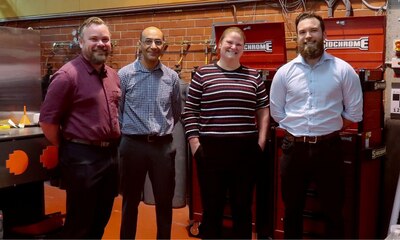3D-printed diamond device powers medical implants

RMIT researchers have created an experimental 3D-printed diamond–titanium device that generates electricity from flowing liquid and receives wireless power through tissue, making it possible to remotely sense changes in flow.
The innovation could one day lead to longer-lasting implants such as smart stents, drug-release systems and prosthetics that never need a battery replacement and are precisely tailored to a patient. It would involve no active electronics in the implant.
The researchers said the research is early but promising, as there are no known devices that can gather energy from both fluid movement and wireless signals, which is enabled by the mix of semiconductive diamonds into a metallic material.
Senior Lead Researcher Dr Arman Ahnood, from RMIT’s School of Engineering, said the advance paved the way for safer devices.
“Our goal was to overcome one of the biggest limits in implant technology — the battery. They take up space and eventually fail, which often means another operation. With this approach, implants could run continuously with little or no onboard battery,” Ahnood said.
The innovation could also have applications outside the biomedical sector.
“The ability to wirelessly receive power and harvest energy from liquid flow could be valuable in many other industries where sensors are needed in hard-to-access places using some of the most inert material systems,” Ahnood said.
“Our device can remotely detect changes in liquid flow in lab tests without the need for any active electronics in the implantable portion, which offers potential for future implants that could warn of progression of disease before it becomes dangerous.”
The device combines lightweight, strong and electrically conductive titanium with many tiny diamond particles. “The diamonds transform titanium from a passive, structural implant material into an active, multifunctional platform — one that can scavenge energy, sense flow and receive wireless power while remaining biocompatible and strong,” Ahnood said.
The device was tested in the lab using saline solutions rather than blood; the researchers believe the same principles could apply inside the body, where blood moving across the surface of an implant could generate energy.
“When liquid flowed across the surface in our lab tests, it produced a small but steady electrical signal. This is completely new — most implant materials are either insulating or conducting — the combination of both in a single material lets us see and use this electricity. On its own this wouldn’t be enough to run most devices, but combined with wireless charging it could power simple implants,” Sherrell said.
The researchers say the innovation needs to undergo further testing and they are seeking partners across biomedical and other sectors to help develop the technology into real-world applications.
The research findings have been published in the peer-reviewed journal Advanced Functional Materials.
AI-powered wearable turns gestures into robot commands
A new wearable system uses stretchable electronics and artificial intelligence to interpret human...
Graphene-based solar cells power temperature sensors
Researchers have demonstrated the ultra-low-power temperature sensors powered by graphene-based...
DNA-inspired design enhances flexible fibre sensors
Drawing inspiration from the double helix of DNA, researchers have created a durable fibre sensor...






